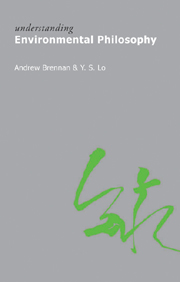Book contents
- Frontmatter
- Contents
- Acknowledgements
- 1 Introduction: the place of environmental philosophy and its basic concepts
- 2 Future generations: what consideration do we owe them?
- 3 Animals: are they as morally valuable as human beings?
- 4 Living things: ethics for the non-human world
- 5 Community: how big is our moral world?
- 6 Natural things: the puzzle of what “natural” means, and whether humans belong to nature
- 7 Foundations: can there be a secular basis for the ideas of human dignity and intrinsic value in nature?
- 8 Origins: political, religious and cultural diagnoses of environmental problems
- 9 Beyond individual responsibility: governance and the affluenzic society
- Questions for discussion and revision
- Further reading
- Bibliography
- Index
5 - Community: how big is our moral world?
- Frontmatter
- Contents
- Acknowledgements
- 1 Introduction: the place of environmental philosophy and its basic concepts
- 2 Future generations: what consideration do we owe them?
- 3 Animals: are they as morally valuable as human beings?
- 4 Living things: ethics for the non-human world
- 5 Community: how big is our moral world?
- 6 Natural things: the puzzle of what “natural” means, and whether humans belong to nature
- 7 Foundations: can there be a secular basis for the ideas of human dignity and intrinsic value in nature?
- 8 Origins: political, religious and cultural diagnoses of environmental problems
- 9 Beyond individual responsibility: governance and the affluenzic society
- Questions for discussion and revision
- Further reading
- Bibliography
- Index
Summary
In a classic study of corporate managers, Robert Jackall quotes one manager as saying: “What is right in the corporation is what the guy above you wants from you. That's what morality is in the corporation” (Jackall 1988: 103). The chief executive of a major bank was recently heard to say: “What's right is what's right for the bank”. So far in this book, we have considered a series of different claims about what is right and wrong, based on ideas about pain, sentience or being a subject of a life, or on respect for nature. None of these views have come close to the view that moral rights and wrongs depend on what other people want, or on what is good for a larger entity of which individuals are only parts. Yet it is obvious that none of us live a life of complete isolation, and our family, the wider society and the natural environment in which we live all play their parts in shaping our beliefs, attitudes, characters and values. Aldo Leopold, an early champion of conservationist thinking, described human beings as “plain members and citizens” of larger biological communities, while in his 1992 book on green political theory, Robert Goodin suggested that: “people want to see some sense and pattern to their lives … That requires in turn that their lives be set in some larger context. The products of natural processes, untouched as they are by human hands, provides precisely that desired context” (Goodin 1992: 37).
- Type
- Chapter
- Information
- Understanding Environmental Philosophy , pp. 87 - 112Publisher: Acumen PublishingPrint publication year: 2010



